The Japanese use herbs and spices to elevate their cooking. Learn about the different herbs and spices and how to incorporate them into your dish!
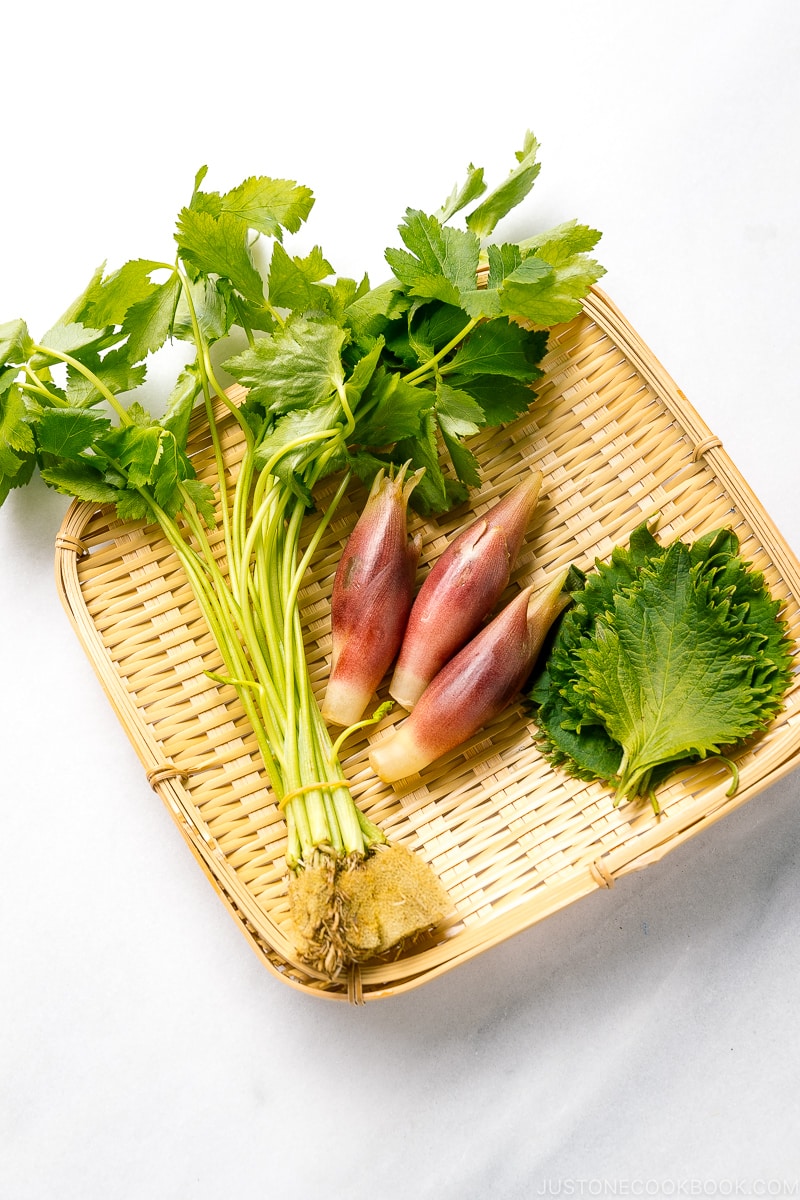
Japanese cuisine is not known for its fiery, robust flavors, boosted by herbs and spices like its neighboring countries. Instead, the Japanese use these flavor enhancers to compliment the dishes, accentuating the other ingredients rather than altering their natural flavors. Thus, these herbs and spices are subtle additions, adding color, aroma, and texture to the presentation.
As early as the eighth century, the Japanese used herbs and spices influenced by Chinese medicine. The philosophy of ishoku dougen (医食同源), “food as medicine,” introduced the idea that a daily balanced diet is indispensable for nourishing oneself against illness and diseases. By consuming foods that also have medicinal properties, you would not need medicine.
You may find these herbs and spices at Asian/Japanese supermarkets or gourmet stores. Perhaps you can grow them yourself for those blessed with a green thumb! (If you’re a JOC subscriber, you know Nami grows a few Japanese herbs and citrus trees at home!) If you cannot find them, I’ve noted a substitution guide.
Table of Contents
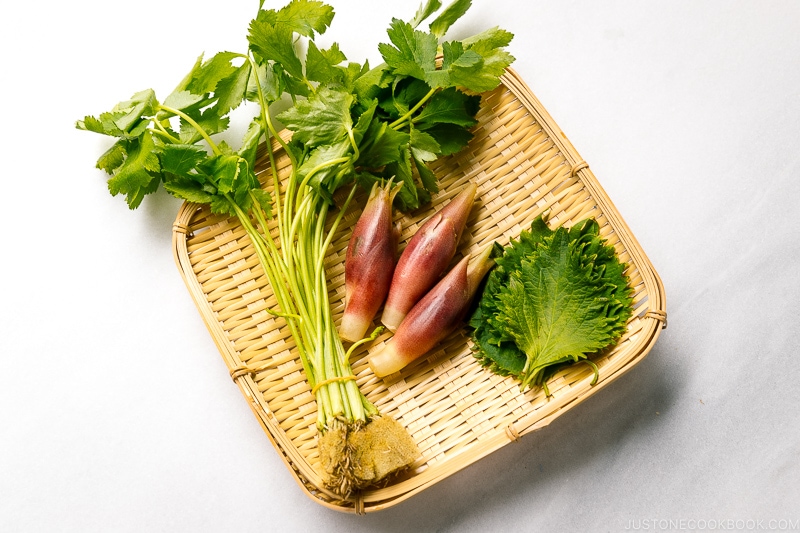
What Are Herbs & Spices?
Herbs and spices add flavor, fragrance, and color to our meals, but can you tell the difference? To refresh your memory, let’s look at their definitions.
The Herb Society of America defines herbs as “small, seed-bearing plants with fleshy, rather than woody, parts. They are valued for their flavor, fragrance, medicinal and healthful qualities, economic and industrial uses, pesticidal properties, and coloring materials.” While fresh herbs are the best for their aroma and flavor, they are also readily available dried.
Spices are “any dried part of a plant, other than the leaves, used for seasoning and flavoring a recipe, but not used as the main ingredient.” You can find spices whole or ground into powder for easy use. Examples include chili peppers, coriander seeds, turmeric, and star anise.
Let’s explore the different varieties of Japanese herbs commonly used and featured in Washoku (和食, Japanese cuisine).
Shiso (紫蘇)
Other names: Perilla leaf, Japanese basil, Ooba (大葉, “big leaf”), Seiso (青蘇)
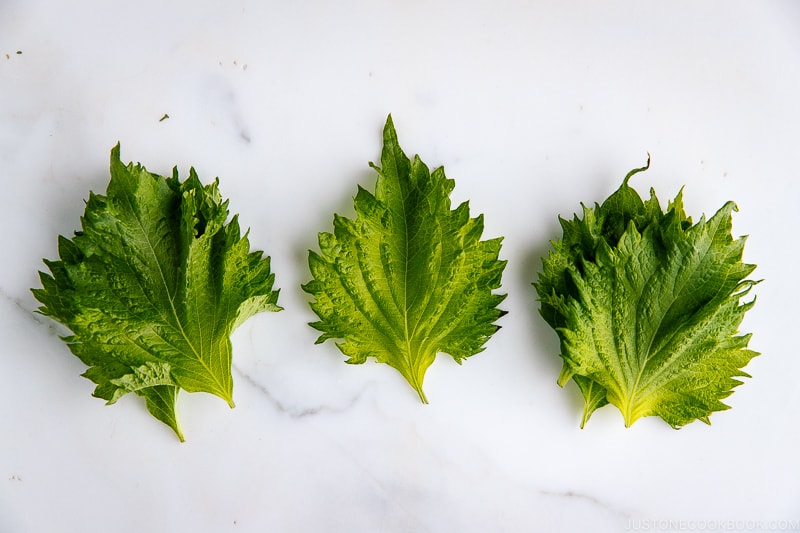
Shiso is a herb in the mint family. The ruffled leaves are either green or dark purple. The plant is also cultivated in other parts of East and Southeast Asia. Shiso is said to prevent food poisoning because of its antibacterial qualities; thus, it is often served with raw fish.
Shiso has a refreshing flavor, and you can also find it fried in tempura, salad dressing, or on wafu pasta. You may even find shiso-flavored Japanese snacks. The green leaves peaking out on a sashimi platter, adding color to the overall presentation. When eaten with a fish slice, it can serve as a palate cleanser. The young seedpods called Ho-jiso (穂紫蘇) and flower stem Hana hoji-so (花穂紫蘇) serve as a garnish for sashimi. You can pluck the seedpods and add them to the soy sauce for flavor.
Red shiso (赤紫蘇) is pickled with Japanese plums to make umeboshi. It imparts a reddish color to the plums. It’s also the main ingredient in making akajiso juice (赤紫蘇ジュース), a magenta-colored refreshing beverage that’s perfect for cooling down during the summer. It’s also used to make the Kyoto pickle shibazuke.
Read more about shiso here.
Suggested substitutions: Given its unique characteristics, it isn’t easy to find the perfect substitution. Here are some ways to substitute for shiso.
- Basil: The basil plant belongs to the same mint family as shiso, although its taste and aroma differ when fresh. Try tempura with basil.
- Korean perilla: Also belonging to the same family as shiso, Korean perilla does look similar to shiso. However, the leaves are broader and thicker, and the aroma is more intense. While it may be too powerful to eat with sashimi, you could use it as a garnish on pasta, tofu, and rice bowls.
- Shiso rice seasoning: A condiment with dried green or red shiso leaves tossed with salt. You could use it to make shiso pasta for flavor and aroma (but it is salty, so adjust accordingly).
Recipes Using Shiso
- Shiso Pesto Pasta (Video) 大葉ジェノベーゼパスタ
- Ume Shiso Rice (Mazegohan) 梅しそ混ぜご飯
- Yukari (Shiso Rice Seasoning) ゆかり
Myoga (茗荷)
Other names: Japanese ginger
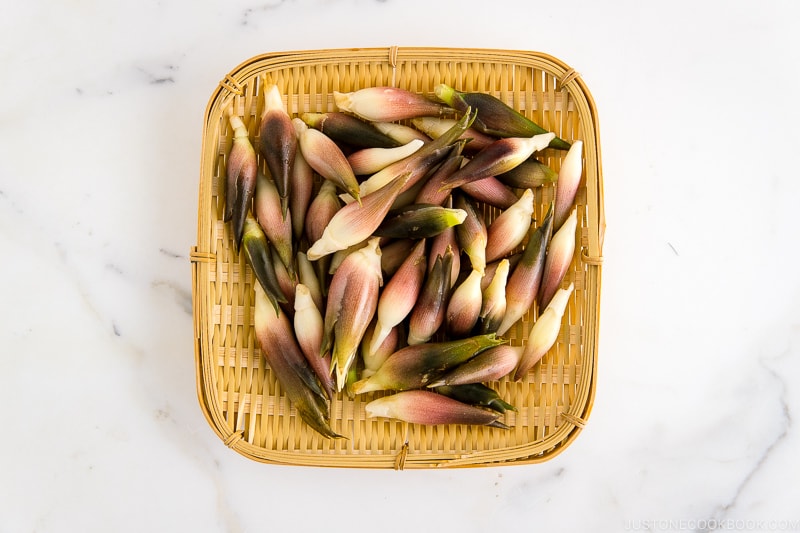
Myoga is a flower bud in the ginger family. It has a delightful crunchy texture and a slightly gingery zesty tang. While it’s associated with the summer season, you can find it year-round in Japan.
Myoga is usually eaten raw, thinly sliced, or julienned. It’s used as a topping for salads, chilled tofu, somen, udon noodles, or mixed into steamed rice. You can add it to miso soup, pickle it for tsukemono, or deep fry it for tempura.
Read more about myoga here.
Suggested substitutions:
- Thinly sliced young ginger: It has a similar zesty flavor to myoga.
- Ginger: Depending on the dish, it may be too strong, so use sparingly.
Recipes Using Myoga
- Myoga Yukari Rice (Mazegohan) ミョウガとゆかりの混ぜご飯
- Eggplant and Myoga Salad なすとミョウガの和え物
- Tomato Myoga Salad トマトとミョウガのサラダ
Mitsuba (三つ葉)
Other names: Japanese parsley
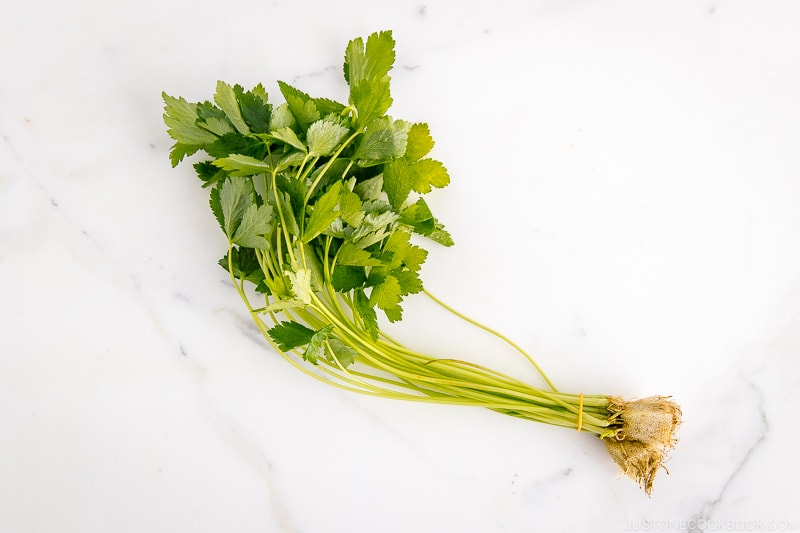
Literally “three leaves,” mitsuba has a thin stalk and trefoil leaves. It resembles flat-leaf parsley and has a crispy texture and a refreshing scent. The flavor is a cross of parsley, celery, sorrel, and cilantro.
Mitsuba serves as a garnish for chawanmushi, oyakodon, ochazuke, etc. You can add it to salads or mix it into tamagoyaki.
Read more about mitsuba here.
Suggested substitutions:
- Cilantro, scallions, green onion: Swap with other green herbs to garnish Japanese dishes.
- Arugula and watercress: You could replace mitsuba with chopped arugula or watercress for salad and rice dishes.
Recipes Using Mitsuba
- Somen Noodle Soup (Nyumen) (Video) にゅうめん
- Beef Udon (Niku Udon) (Video) 肉うどん
- Matsutake Suimono (Clear Soup) 松茸お吸い物
Wasabi (山葵)
Other names: Japanese horseradish
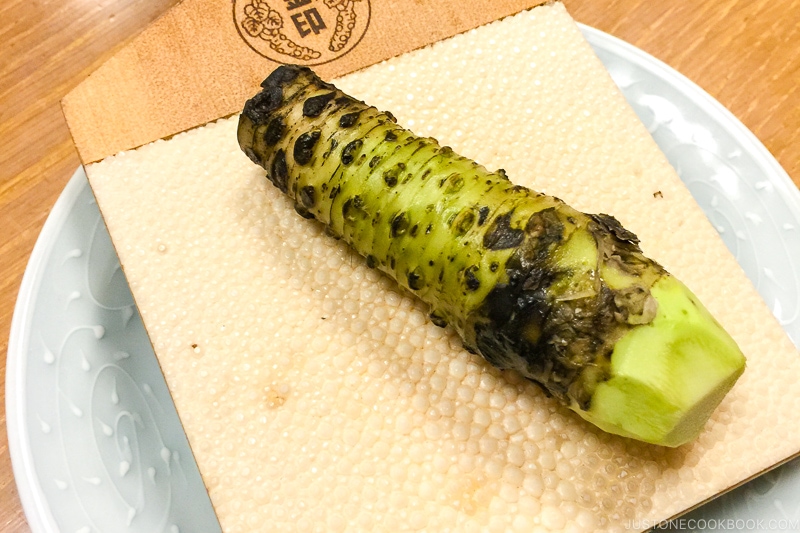
Probably the most iconic Japanese herb, wasabi burns your nose instead of your tongue. Wasabi is a plant of the Brassicaceae family, which includes cruciferous vegetables. As wasabi grows along stream beds with clean mountain water, fresh wasabi is a luxury. Shimane, Shizuoka, and Nagano prefectures are famous for their high-quality wasabi.
You may be familiar with the green paste served with sushi, sashimi, cold soba, and more. The rhizome looks like a short, stubby root which is finely grated. As wasabi loses its pungency and aroma with time, upscale restaurants often grate a small amount upon order. Most sushi chefs will proudly share where the wasabi came from and refrain from doling out extras to diners.
Besides the root, you can eat other parts of the wasabi. The wasabi leaves and stems are chopped and mixed with sake lees to make wasabi zuke (わさび漬け), which is commonly eaten with rice or kamaboko.
For home consumption, the paste or powdered form is the most accessible. Cheap wasabi is usually a horseradish and green food coloring. There is some tube wasabi with real wasabi, so check the label before buying.
Read about the JOC family’s trip to a wasabi farm and more on wasabi here.
Suggested substitutions:
- Japanese mustard, yuzu kosho: While it won’t have the same tingly spiciness, you can substitute wasabi for sushi with either.
Recipes Using Wasabi
- Ultimate Sushi Guide: Sushi Types, Recipes & Etiquettes
- Zaru Soba (Cold Soba Noodles) ざるそば
- Ochazuke お茶漬け
Ginger (生姜)
Other names: shoga
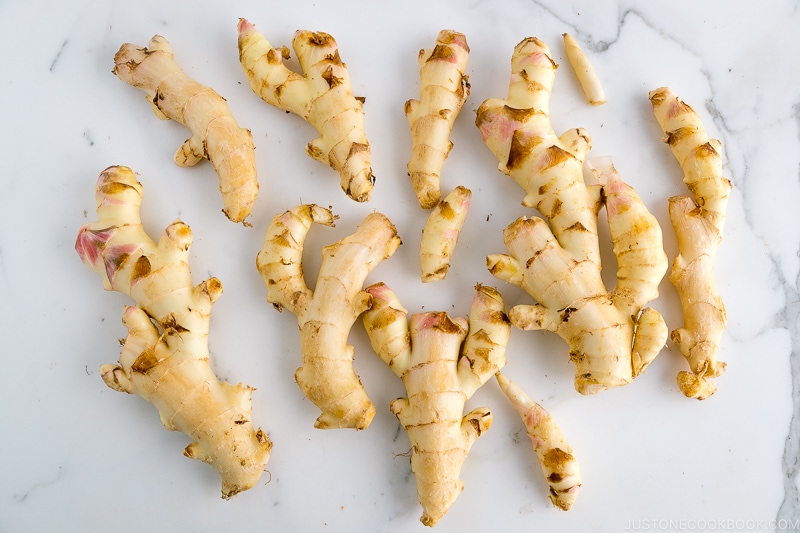
Ginger is a rhizome used worldwide as a spice, flavoring, and in traditional medicine. It’s a herbaceous perennial plant of the ginger family. It’s native to southeast Asia.
In Japanese cuisine, ginger is pickled for beni shoga and gari, serving as a palate cleanser. Sliced ginger is added to cooked fish to remove the fishy smell, grated raw on noodles, and chilled tofu. Young ginger called shinshoga (新生姜) becomes available in spring with a milder ginger flavor with a hint of floral fragrance.
Suggested substitutions:
- Ground ginger: ground ginger is much more potent than fresh, so use a small amount first
- Galanga: another type of rhizome, galanga has a citrusy flavor but depending on the dish, this may not be a good substitute
- Myoga: has a similar zingy bite
Recipes Using Ginger
- Ginger Pork (Shogayaki) 豚の生姜焼き
- Honey Ginger Tea (Shogayu) 生姜湯
- Okra with Ginger Soy Sauce オクラの生姜醤油和え
Karashi (辛子)
Other names: Japanese hot mustard

Karashi is a spice consisting of crushed mustard seeds of Brassica juncea and horseradish. The mustard yellow paste has a fiery kick than regular yellow mustard and will make your nose tingle like wasabi. You can find it sold in tubes or powdered form. It’s a condiment for many Japanese dishes such as oden, gyoza, natto, and tonkatsu. It’s also a pickling agent in karashizuke, a karashi, and sake lees-based tsukemono.
Suggested substitutions:
- English mustard, Chinese hot mustard
Recipes Using Karashi
- Karashi Renkon (Lotus Root with Japanese Mustard) 辛子蓮根
- Asparagus with Miso Dressing (Karashi Sumisoae) アスパラガスの辛子酢味噌和え
- Chicken Tempura (Toriten) とり天
Shichimi Togarashi (七味唐辛子)
Other names: Japanese seven-spice, nanami togarashi
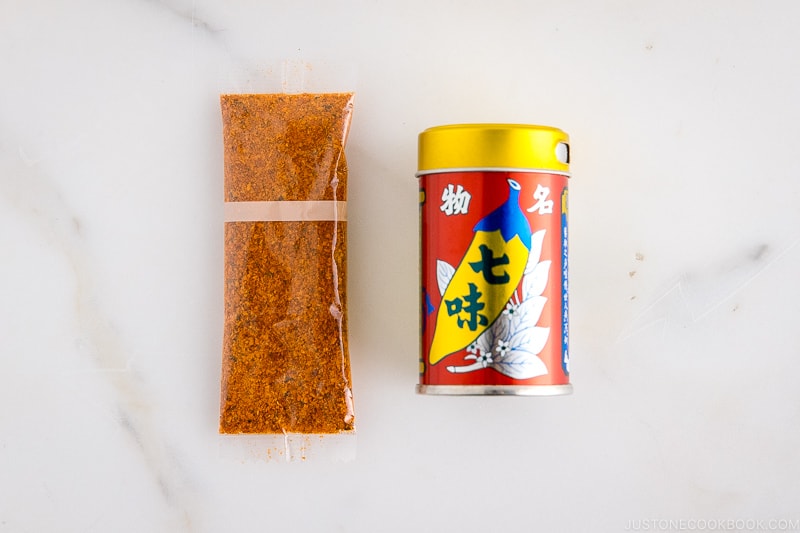
Shichimi togarashi (“seven flavored chili peppers”) is a spice blend featuring dried red chili pepper, sansho pepper, hemp seeds, white and/or black sesame seeds, mandarin orange peel, and nori. It adds a subtle citrusy, nutty, umami complexity, which is sprinkled over udon and soba noodles, gyudon, tonjiru, yakitori, and hot pot. It’s a pantry staple that’s both an all-purpose condiment and a finishing seasoning.
There are regional differences in the balance and differences of ingredients, such as the addition of yuzu peel, shiso leaves, poppy seeds, and ground ginger. The three historic shichimi producers are Yagenbori in Asakusa, Tokyo, Shichimiya in Kiyomizu, Kyoto, and Yawata Isogoro in Zenkoji, Nagano.
Suggested substitution:
- Ichimi togarashi
Recipes Using Shichimi Togarashi
Ichimi Togarashi (一味唐辛子)
Other names: ground red chili pepper
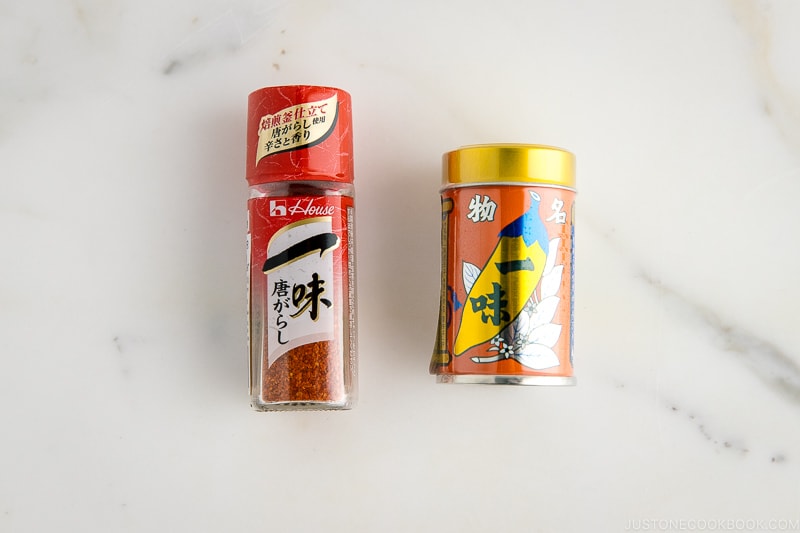
Literally “one flavored chili pepper,” ichimi togarashi is a chili powder made of ground red chili pepper. It’s much more straightforward in the spiciness than shichimi togarashi as it doesn’t have the additional spices and herbs. You can sprinkle it over noodles, rice bowls, and hot pot dishes like shichimi togarashi.
Suggested substitution:
- Shichimi togarashi
Recipes Using Ichimi Togarashi
- Spicy Bean Sprout Salad ホットもやし
- Myoga Shiso Rice (Mazegohan) ミョウガとしその混ぜご飯
- Ankimo あん肝
Sansho (山椒)
Other names: Japanese pepper
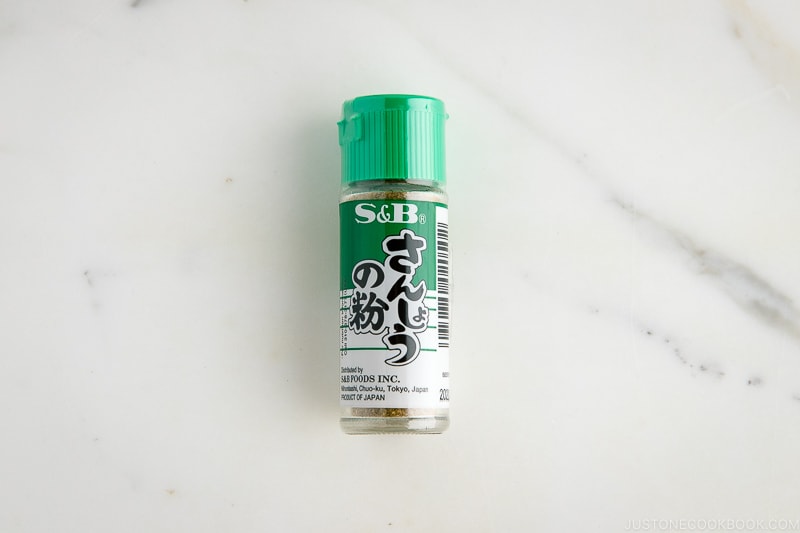
Sansho is a cousin to the Chinese Sichuan peppercorn. The peppercorns come from the Japanese prickly ash. The citrus-peppery flavor gives a pleasant, tingly, lasting sensation on the tongue.
The Japanese sprinkle the dried and ground peppercorns on grilled eel and yakitori. It’s also one of the ingredients for the seven-spice blend shichimi togarashi. The tender young leaves called kinome (木の芽, literally “tree buds”) are garnished on grilled fish, nimono, rice, and soups.
Read more about sansho here.
Suggested substitutions:
- Sichuan pepper: Sichuan peppers have a more pronounced numbing effect and taste floral than sansho. However, you can replace it with ground Szechuan pepper.
- Shichimi togarashi: While it contains other spices, store-bought shichimi togarashi may work depending on the dish.
- Lemon pepper blend: While this won’t replicate that tingly residual heat sensation, you could blend ground black pepper and lemon zest.
Recipes Using Sansho
- Unadon (Eel Rice) (Video) 鰻丼
- Kenchinjiru (Japanese Vegetable Soup) (Video) けんちん汁
- Hokkaido Salmon Hot Pot (Ishikari Nabe) 石狩鍋
In the next post, let’s look at the different Japanese vegetables you may encounter when cooking Japanese cuisine.

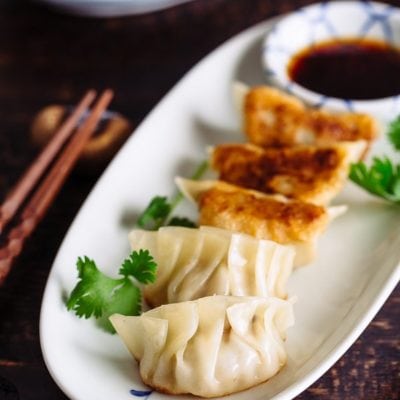
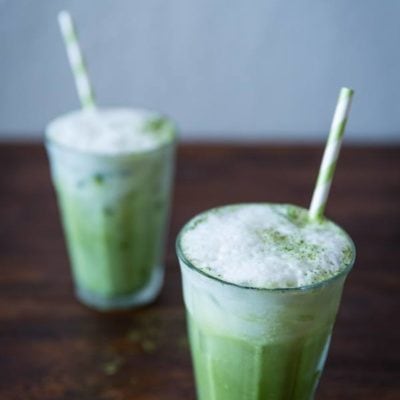


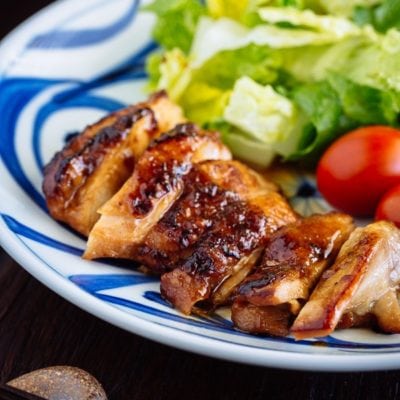
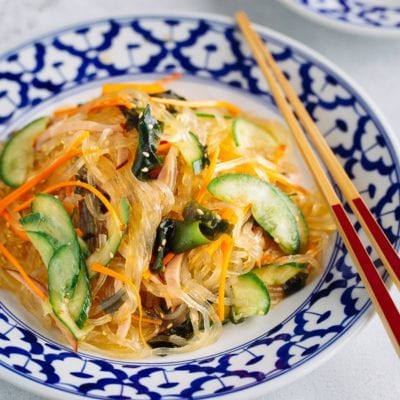
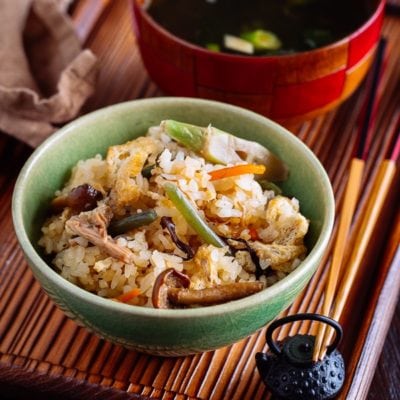
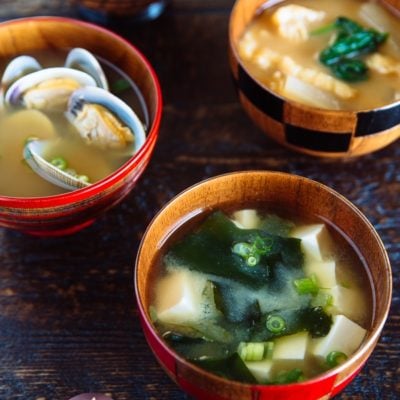

Thank you, thank you for the yukari recipe!! I made the mistake of plant red shiso in my garden years ago, and now the darn plant is sprouting up like weeds all over the place! When I weed my garden I pick a ton of red shiso. Now I can make a lot of yukari instead!
Hi Sharon, glad to hear you found a recipe to use up your red shiso! I will pass on your happy comment to Namiko san 🙂
The part about the sansho brought memories of my visits with my relatives in Kyoto and in the Fukuchiyama area. But we also used the leaves for seasoning, too. My mother planted a sansho bush in her garden and I would pick some leaves to take back to my kitchen.
Hi Sharon, thank you for sharing your memory! Sansho leaves are a luxurious garnish that you don’t see in every day cooking but that’s wonderful that your mother planted one in her garden.
Great article. Any suggestions on where we may either purchase the herbs in the article or preferably sources to purchase seeds/plants so that we may grow them ourselves?
Hi Sarah! Thank you for reading. To start, try checking plant shops or nurseries in your local area, or ask the vendors if you see any of the herbs sold at farmers’ markets. It’s a little difficult to offer suggestions as our readers are from around the world. Good luck!
Very interesting article! It will be fun to test out a Japanese-style chimichurri w/ an assortment of these.
Hi Matt! Thanks for reading! If you do make a Japanese-style chimichurri, please tag us @justonecookbook on social media so we can take a look! Hope it turns out great!
Are these all herbs and spices available in other countries easily?
Hi Mate Mate! I can’t speak on behalf of all supermarkets/grocery stores outside of Japan, but there’s a good chance you can find it at an Asian or Japanese supermarket. Good luck!